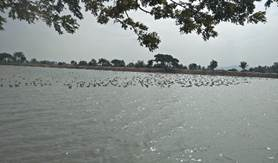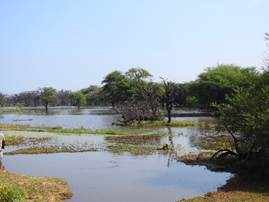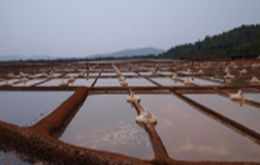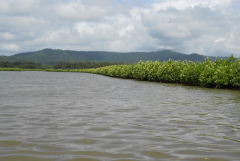TAG: GS 3: ECOLOGY AND ENVIRONMENT
THE CONTEXT: India celebrates the addition of five new wetlands to the prestigious Ramsar list, marking them as internationally recognized ecosystems of significance.
EXPLANATION:
- Union Environment announced this accomplishment, highlighting the total count of Ramsar-listed wetlands in India reaching 80.
- The newly designated sites include Magadi Kere Conservation Reserve, Ankasamudra Bird Conservation Reserve, and Aghanashini Estuary from Karnataka, along with Karaivetti Bird Sanctuary and Longwood Shola Reserve Forest from Tamil Nadu.
- The announcement of the addition of five wetlands to the Ramsar list comes just days before World Wetlands Day, reinforcing India’s commitment to wetland conservation on the global stage.
- The timing of this achievement aligns with international efforts to raise awareness about the vital role wetlands play in environmental sustainability.
Ramsar Convention and Global Recognition:
- The Ramsar Convention, initiated in 1971, is an international treaty dedicated to the conservation and sustainable use of wetlands.
- With its focus on maintaining the ecosystem components, processes, and benefits of wetlands, the convention aims to establish and preserve a global network of vital wetland areas.
- The recent addition of five Indian wetlands accentuates the country’s commitment to global biodiversity conservation.
Geographical Distribution of New Ramsar Sites:
- The Ramsar list’s newest entrants are geographically diverse, representing both Karnataka and Tamil Nadu.
- Magadi Kere Conservation Reserve, Ankasamudra Bird Conservation Reserve, and Aghanashini Estuary contribute to Karnataka’s wetland heritage, while Karaivetti Bird Sanctuary and Longwood Shola Reserve Forest enhance Tamil Nadu’s ecological significance.
Significance of Ramsar Recognition:
- Inclusion in the Ramsar list signifies the global importance of these wetlands for biodiversity conservation and human sustenance.
- The Ramsar Convention’s objective is to recognize, protect, and promote the wise use of wetlands, acknowledging their critical role in supporting life and maintaining ecological balance.
Collaborative Efforts and International Recognition:
- India’s collaborative efforts involving various national and international organizations contribute to this success.
- The Ramsar Convention’s Secretary General commended India’s dedication to wetland conservation during a meeting in Delhi.
- The international recognition of India’s wetlands underscores the importance of collective action in preserving the planet’s critical ecosystems.
Magadi Kere Conservation Reserve:
- It is a human-made wetland with an area of nearly 50 hectares which was constructed to store rainwater for irrigation purposes.
- It is home to over 166 species of birds, of which 130 are migratory. The wetland harbours two vulnerable species, namely Common pochard (Aythya ferina) and River tern (Sterna aurantia) and four near-threatened species, namely Oriental Darter (Anhinga melanogaster), Black-headed Ibis (Threskiornis melanocephalus), Woolly- necked Stork (Ciconia episcopus) and Painted Stork (Mycteria leucocephala).
- Nearly 8,000 birds visit the site during winter. Magadi Kere is also one of the largest wintering grounds for the Bar-headed goose (Anser indicus) in Southern India.
- The wetland is a designated Important Bird Area (IBA) and also listed as a priority area for conservation in India.


Panoramic view of Magadi Kere
Ankasamudra Bird Conservation Reserve:
- It is a humanmade Village Irrigation Tank built centuries back and is spread over an area of 98.76ha (244.04 acre) adjoining the Ankasamudra village.
- It is an ecologically important wetland, rich in biodiversity, comprising over 210 species of plants, 8 species of mammals, 25 species of reptiles, 240 species of birds, 41 species of fishes, 3 species of frogs, 27 species of butterflies and 32 species of odonates.
- Over 30’000 waterbirds nest and roost at this wetland, which also supports more than 1% of the biogeographic population of Painted Stork (Mycteria leucocephala) and Black-headed Ibis (Threskiornis melanocephalus).


A view of Ankasamudra Bird CR Checkered keelback at Ankasamudra
Aghanashini Estuary:
- It is spread over an area of 4801 ha, is formed at the confluence of Aghanashini River with the Arabian sea.
- The brackish water of the Estuary provides diverse ecosystem services including flood and erosion risk mitigation, biodiversity conservation and livelihood support.
- The wetland also provides livelihoods to 6000-7500 families by supporting fishing, agriculture, collection of edible bivalves and crabs, shrimp aquaculture, traditional fish farming in the estuarine rice fields (locally known as Gazni rice fields), bivalve shell collection and salt production.
- Additionally, the mangroves bordering the estuary help to protect the shores against storms and cyclones.
- The estuary regularly supports over 43,000 counts of over 66 waterbird species and over 1% of the biogeographic population of 15 waterbird species (which includes river tern, oriental darter, lesser black-backed gull, woolly- necked stork, Eurasian oystercatcher and others).


Aghanashini estuary with mangroves blending
Karaivetti Bird Sanctuary:
- Spanning 453.72 ha is one of the largest inland wetlands of Tamil Nadu and is a significant source of groundwater recharge for the area.
- Water from the wetland is utilized by the villagers for cultivating agricultural crops such as paddy, sugar cane, cotton, corn, and split red gram.
- Karaivetti has one of the largest congregations of waterbirds in the State of Tamil Nadu.
- About 198 species of birds have been recorded here; some of the important visitors being the Bar headed Goose, Pin-tailed duck, Garganey, Northern Shoveler, Common Pochard, Eurasian Wigeon, Common teal and Cotton teal.

Karaivetti Wetland
Longwood Shola Reserve Forest from Tamil Nadu:
- It derives its name from the Tamil word, “Solai”, which means a ‘tropical rain forest’.
- The ‘Sholas’ are found in the upper reaches of the Nilgiris, Anamalais, Palni hills, Kalakadu, Mundanthurai and Kanyakumari in Tamil Nadu.
- These forested wetlands serve as habitats for the globally endangered Black-chinned Nilgiri Laughing thrush (Strophocincla cachinnans), Nilgiri Blue Robin (Myiomela major), and vulnerable Nilgiri Wood-pigeon (Columba elphinstonii).
- As many as 14 out of 26 endemic birds species of the Western Ghats are found in these wetlands.

Ramsar Sites:
- Any wetland site which has been listed under the Ramsar Convention that aims to conserve it and promote sustainable use of its natural resources is called a Ramsar Site.
- Ramsar Convention is known as the Convention of Wetlands.
- It was established in 1971 by UNESCO and came into force in 1975.
- India is a party to the Ramsar Convention. India signed under it on 1st February 1982.
- The Ramsar Convention works closely with six organizations known as International Organization Partners(IOPs). These are:
- Birdlife International
- International Union for Conservation of Nature (IUCN)
- International Water Management Institute (IWMI)
- Wetlands International
- World Wide Fund for Nature (WWF)
- International Wildfowl & Wetlands Trust (WWT)
Conclusion:
- The inclusion of these five wetlands in the Ramsar list signifies a significant accomplishment for India in the realm of environmental conservation.
- As the country continues to prioritize the protection of wetlands, this achievement reinforces its commitment to global biodiversity goals.
- The recognition of these wetlands as internationally important ecosystems adds another chapter to India’s environmental stewardship and serves as an inspiration for sustained efforts towards ecological preservation.

